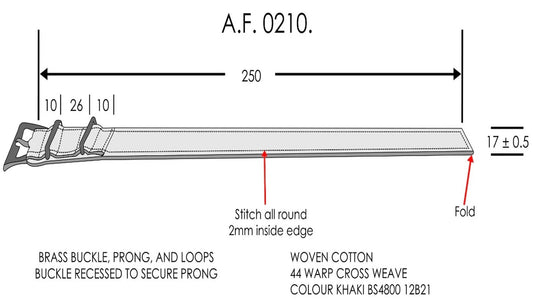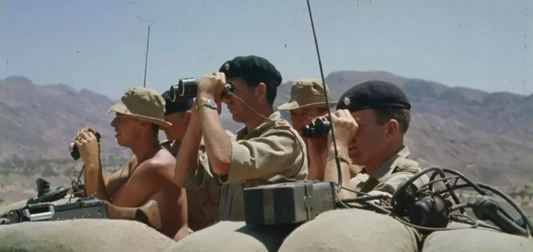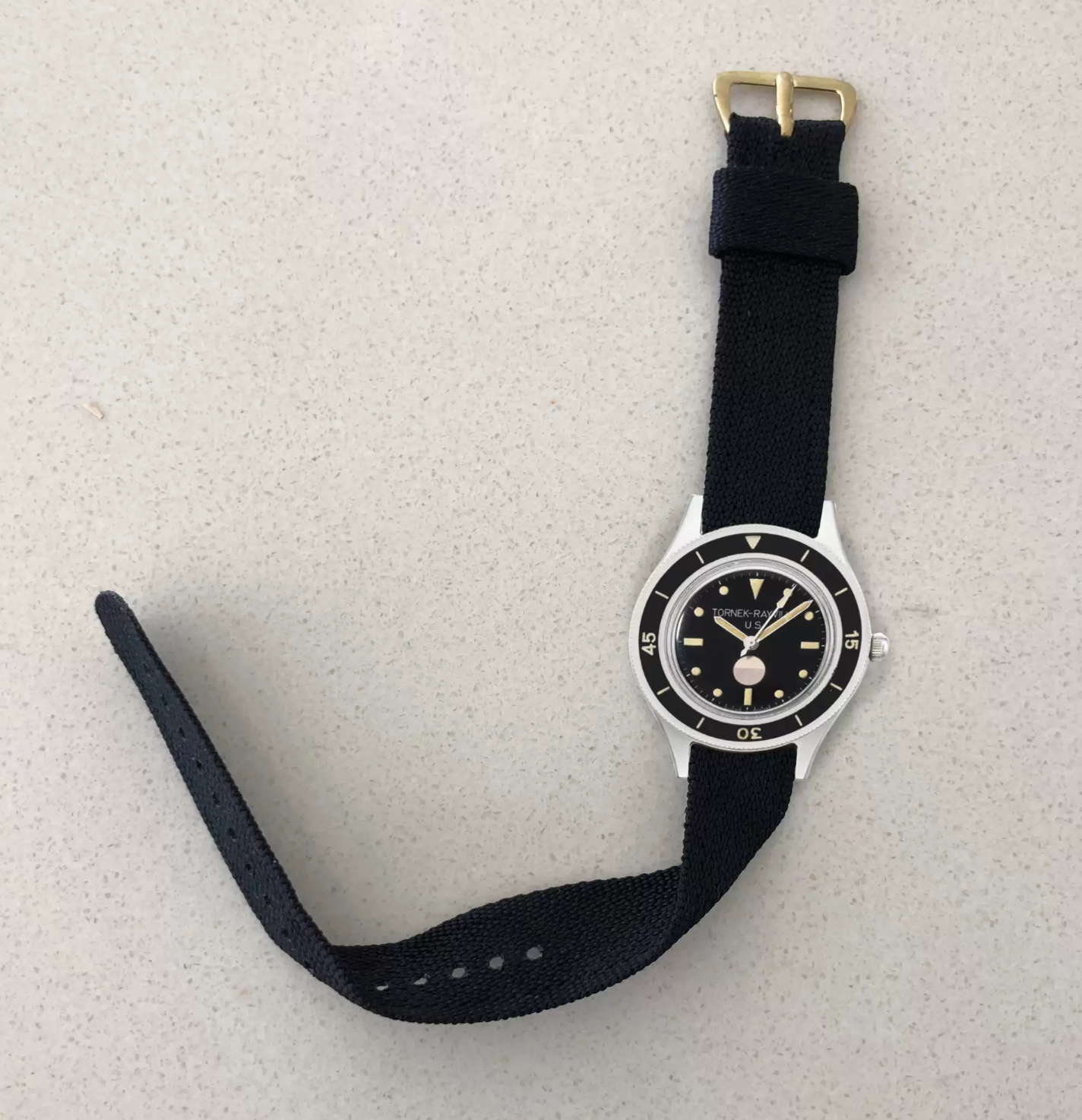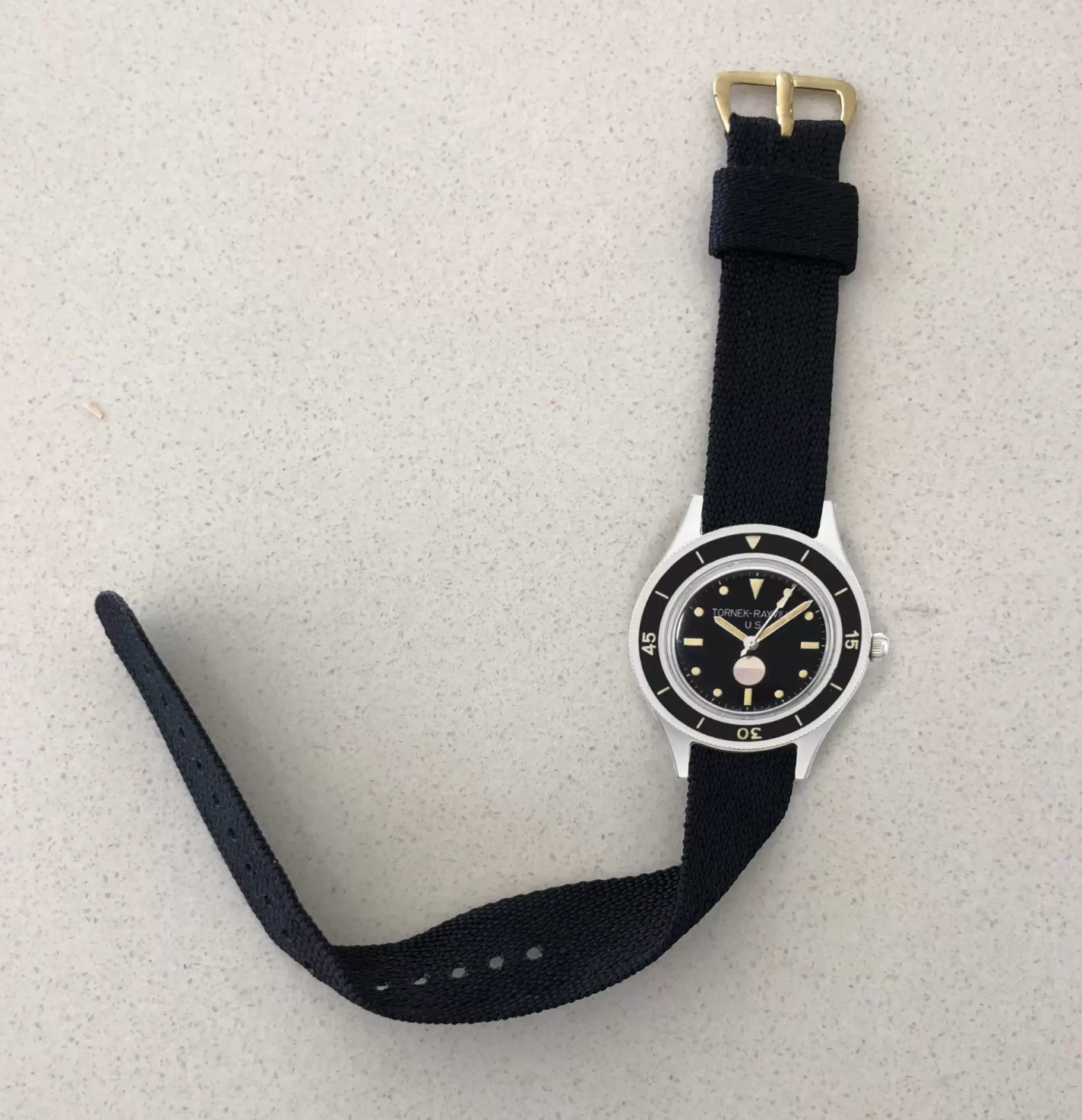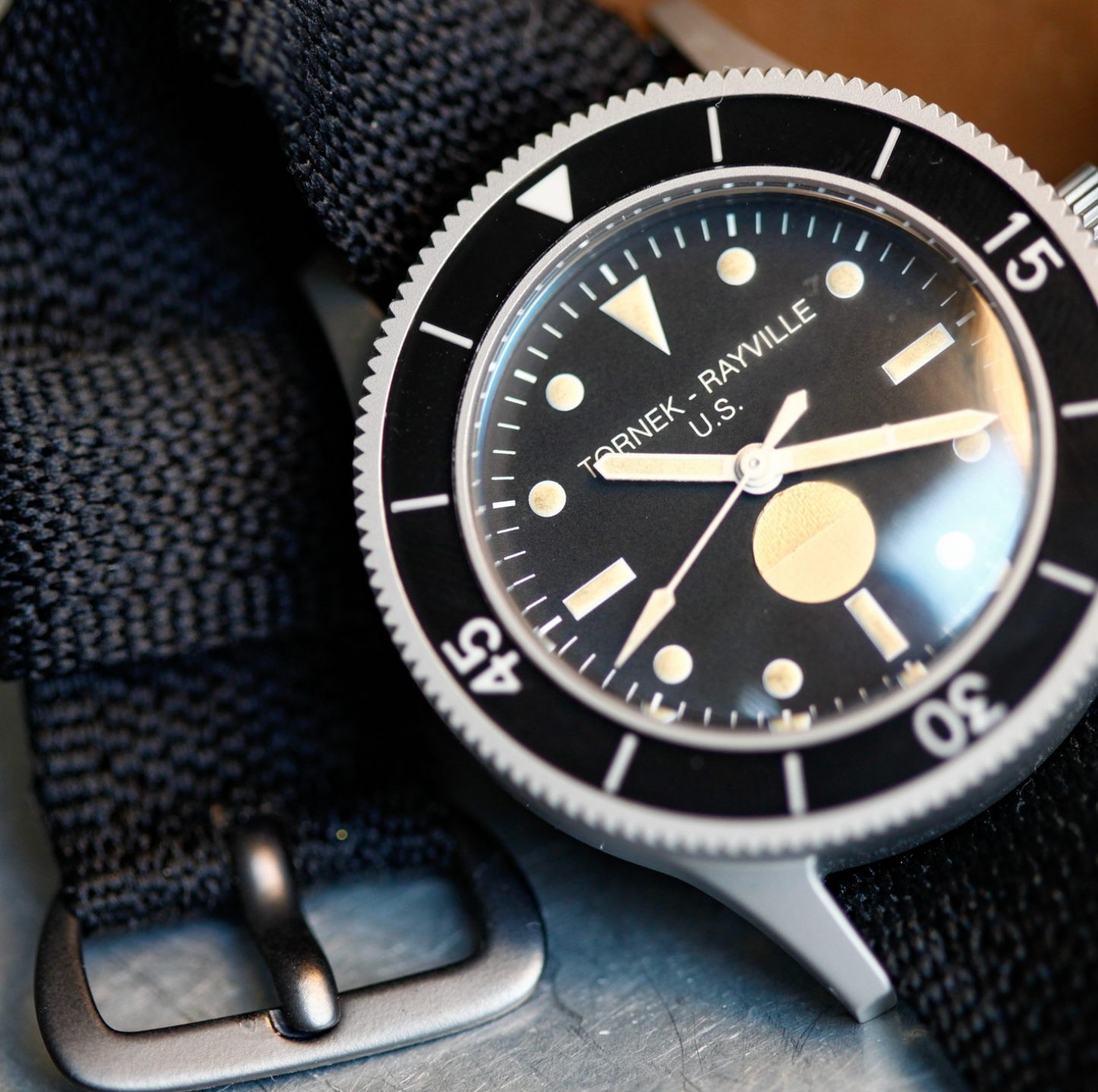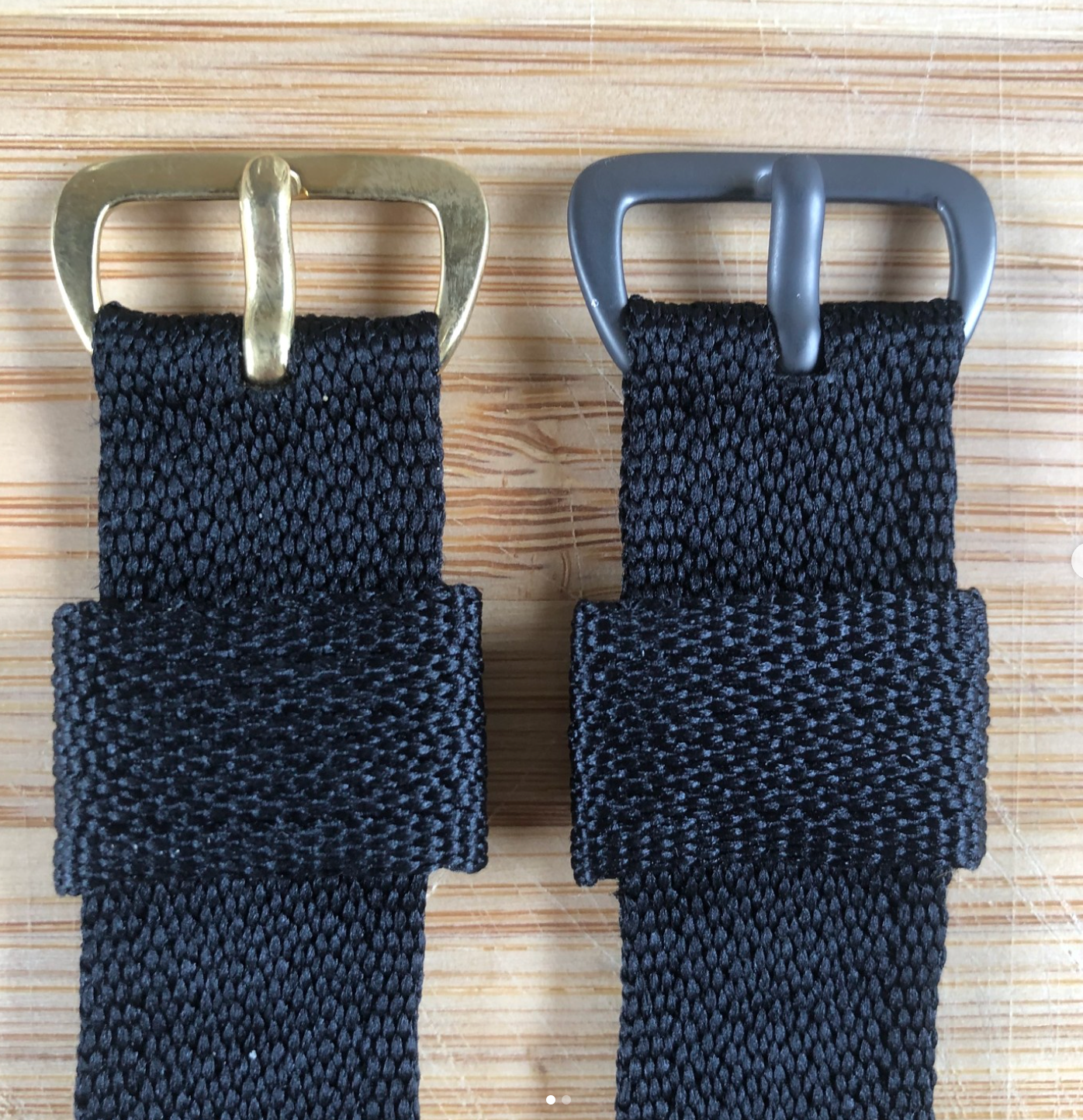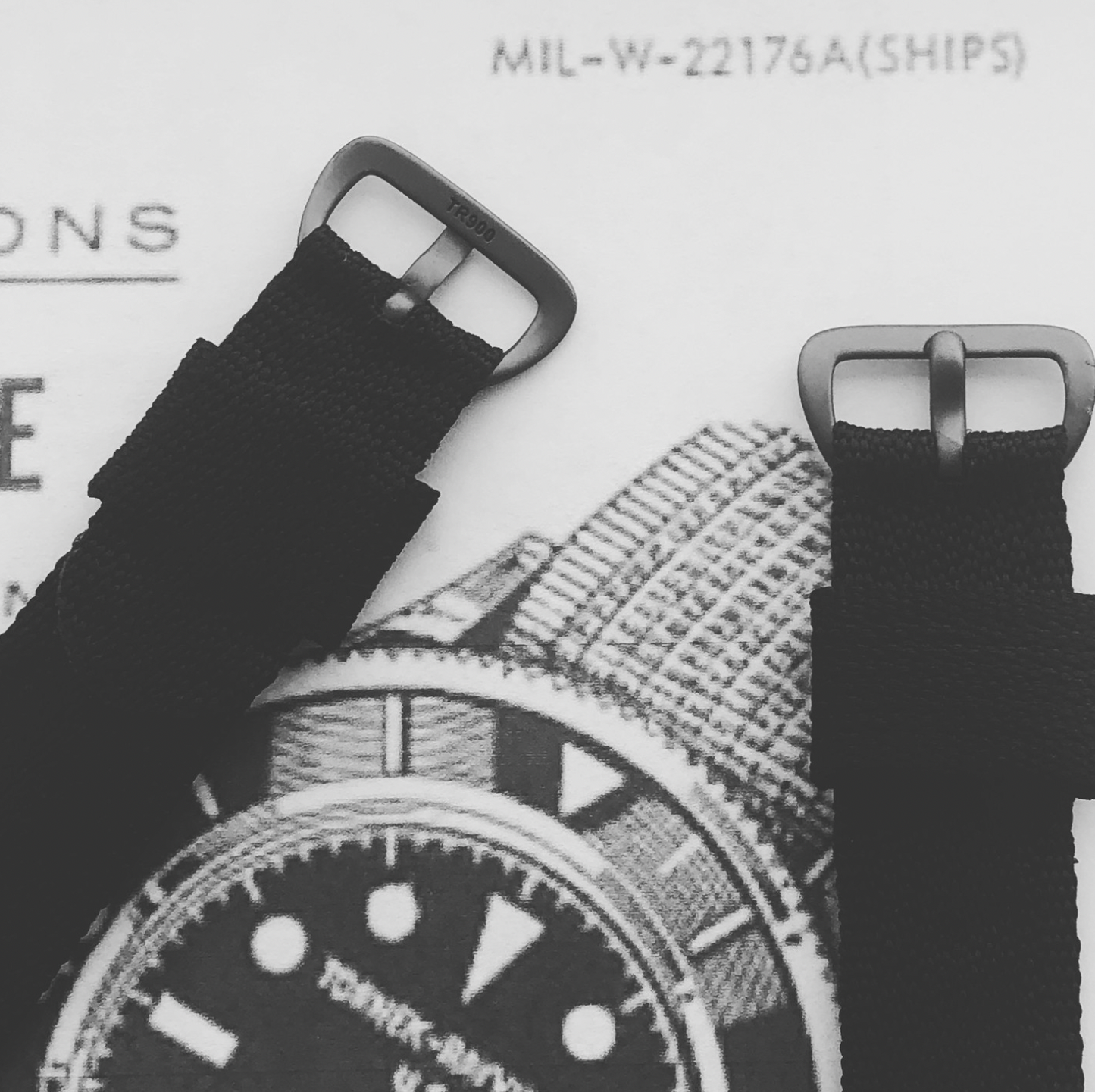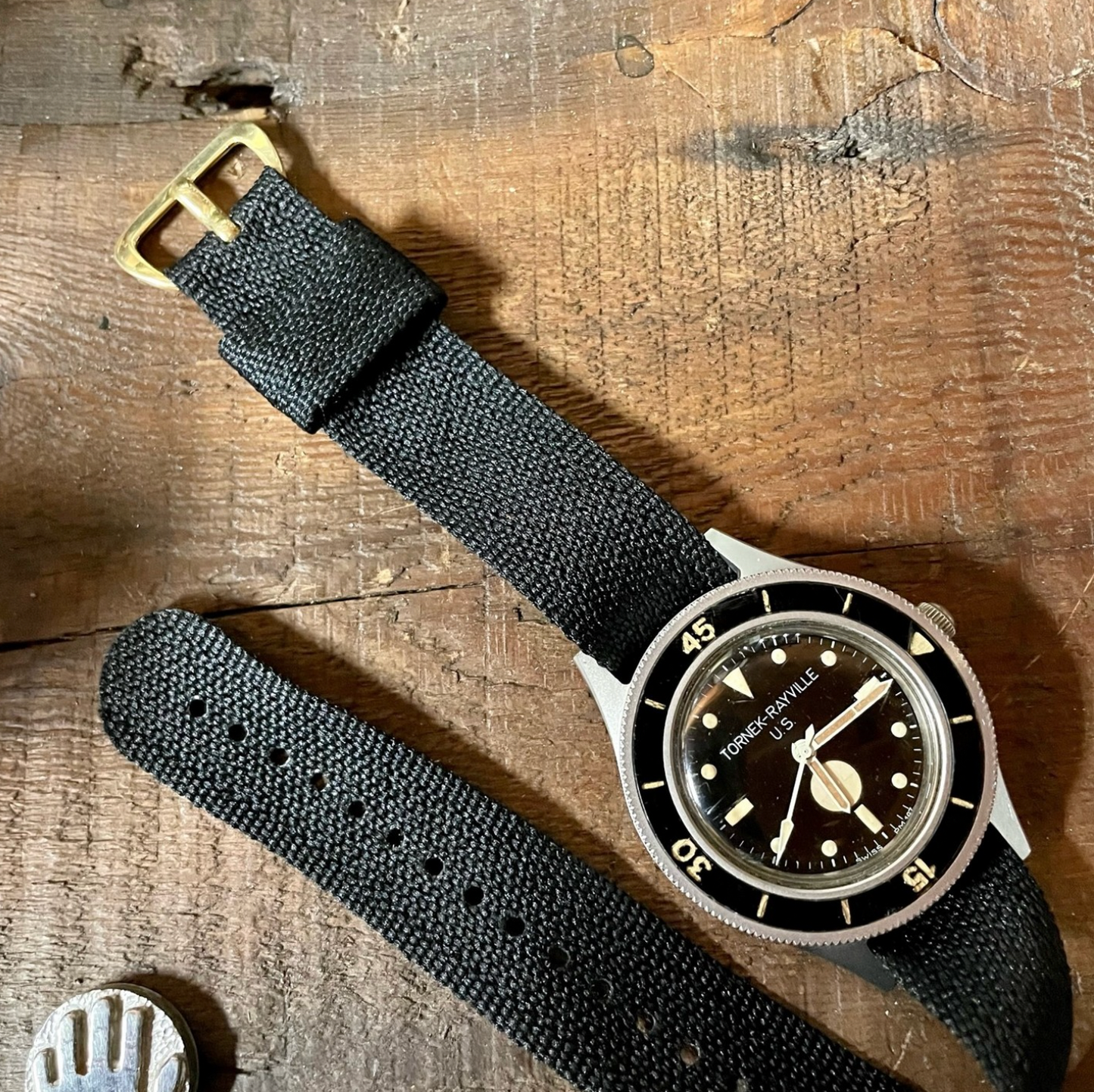Above is a rare combination of Lemania central seconds ATP on an original AF0210 strap. Both are currently difficult to find. Three other Lemania center seconds ATP watches are shown on our reproduction straps.
And, below is a collage of our ATP watches on our straps.

The ATP watch and the AF0210 strap were the only combination of watch and strap to be issued in WW2, and continued to be available in military stores after the war until 1957 and 1980 respectively.
Because of this unique military combination, we have been purchasing ATP watches to illustrate the long standing relationship.
We have a vacancy in our lineup below, and if you have an ATP watch to fill it, please contact us on af0210strap@gmail.com

In alphabetical order, the ATP watches were produced by the manufacturers : Buren, Cortebert, Cyma, Ebel (2 case types), Enicar, Eterna, Fontainemelon, Grana, Lemania (central seconds and sub seconds), Leonidas, Mido, Moeris, Reconvilier, Record, Revue (Cal 57 and Cal 59), Rotary, Timor, Unitas and Wyler. Overall, 19 manufacturers, and 22 case and movement types.

INTRODUCTION
The Army Trade Pattern (ATP) series of watches were made available at the commencement of WWll via a MoD contract with Swiss watch manufacturers in 1939. In an effort to demonstrate neutrality, the Swiss supplied almost identical watches to Germany, but with black dials. Some of these corresponding D-H watches are discussed below.
Leading into WWII the ATP watch was issued to soldiers and was supplied to the Ministry of Defence (MoD) by 19 Swiss suppliers, under brand names Buren, Cortebert, Cyma, Ebel, Enicar, Eterna, Font (Fontainemelon), Grana, Lemania, Leonidas, Mido, Moeris, Reconvilier, Record, Revue, Rotary, Timor, Unitas and Wyler. Ebel, Revue and Timor produced 2 types of watch, so about 22 watch types were in the ATP series. The Army catalogue number was VA/VC 7471.
Most had the following characteristics:
15 jewelled movement with a round waterproof case about 31mm diameter in stainless steel or nickel chrome, white dial with railroad track chapter ring marked in minutes, luminous index spots, and broad lumed baton hands and a silvered subsidiary seconds register, with an accuracy +/- 30 seconds per day. They all were to have fixed bars between lugs.
On the dials only the Buren had a single sided railroad chapter ring, and only the Ebel (poire squelette) and Reconvilier (Dauphine) hands varied. Lemania and Eterna provided central seconds watches. The subseconds dials and hands varied more.
133,600 ATP watches were purchased at an average price of £3. After WWll many were decommissioned, and some continued in service. In a decommissioning document they were described as :

Image courtesy MWR forum member : HQ_Sandman_Ute
The military stores number was initially VC7471, but later individual stores numbers were issued W10/10053 to 10072.
The ATP watch was deleted from the stores list by an amendment dated February 3, 1957, just after the W10 watch designation was introduced.

ATP DECOMMISSION ADVERTISEMENT. COURTESY MWR FORUM USER : DAVE
Many ATP watches are engraved Bravingtons, indicating they were decomissioned stock.
A few have replacement dials, either sterile or signed.
The MWR forum user Bobsy has listed ATP sales over a 4 year period, which gives some idea of the availability of the following 20 watch types.

The watches were supplied to the MoD without straps. They were then fitted by the MoD with open ended leather straps with folded metal butterfly clips as seen on the Grana ATP below.
The engraving on the case back was generally the pheon, together with A.T.P. and an issue number, although the issue number was sometimes missing.

Leather straps often perished in tropical conditions and canvas straps were used, particularly in Asia and the Pacific. The 44 pattern webbing was designed and issued for tropical conditions, and the AF0210 strap was issued in 1945 as part of this Jungle Warfare Equipment. The military prefix for these stores was A6/AFxxxx.
Here is the Reconvilier ATP, on an AF0210 strap, together with an AF0003 rubberised food bag. The AF0210 strap was introduced by the MoD for military watches and compasses in 1945, with a stores description A6/AF0210 : STRAP, WRIST, INSTRUMENT, quickly shortened to the AF0210 strap. The stores description of the food bag was A6/AF0003 : BAGS Food.

The combination of the ATP watch, and the AF0210 strap is the only true combination of issued watch and strap from WW2.
Below is a rare combination. The hard to find Reconvilier ATP watch on an original WWII period AF0210 canvas strap. ATP watches on AF0210 straps have recently sold on ebay with an approximate strap value of £400. The strap fitted quickly and easily under the fixed bars of the ATP watch.

The various ATP watches are described individually below on A.F.0210. straps.
The lug width and diameter ex crown for the various makes has been listed below.

BUREN
The Buren ATP is reasonably rare, being 7th in the list of 20 watches above, and maybe only 2,500 were issued. The watch serial number was engraved on the case (1413xx to 1438xx), a range of some 2,500 watches. The case number was 1021 and this was engraved between the lugs, easily seen as the watch had spring bars. The watch had pencil hands with syringe tips, and a stick sub seconds pointer. The sub seconds dial has 15, 30, 45, 60 placed radially. The case back was a 6 slot screw fitting.
The 10.5″‘ Buren 410 movement is used with a sub second dial, and the crown wheel is engraved Buren Grand Prix. The Buren 411 movement has a sweep second hand.

Buren ATP on our VB Hygienique strap..

The three fingered Buren Cal. 410 movement and retaining ring above with 6 slot case back. Below, case engraved 1021 between the lugs as well as inside the case back.

The Buren is often seen engraved Bravingtons.
Below is a MoD redial Buren, with a simplified signature (no tags on the letters), dial and sub-dial, and a Bravingtons case, shown on a 6B/2617 strap, together with an original watch on an olive green AF0210 strap. Some Buren ATPs have had a dash of lume added at 3 and 9 between the dots.

And, a Breguet style MoD redial, with no numerals on the sub dial, and a counterweight pointer.

The later Buren WWW watch has been seen re-engraved ATP, so is this an ATP watch or a WWW watch or an anomaly?

Buren also produced a German D-H watch, with a black dial in WWII, shown on the right below. (D stands for Dienstuhr (Service Watch) and the H = Heer (Army)).

Just as there were desired characteristics for the ATP watch, with a few exceptions the basic D-H wristwatch had the following characteristics:
About 34mm outside case diameter.
Black dial with luminous numbers and hands
Fixed bars, either steel pins or cast as part of the case. There are a few exceptions with spring bars.
Threaded case back with 6 wrench slots
15 jewel movement with shock resistance.
Plastic crystal
The cases are mostly chrome plated brass, some are all stainless steel.
Of the various manufacturers, those who did not make their own movement mostly used the A.S. 1130 movement produced by Anton Schild, of Grenchen, and consequently some people call the A.S. 1130 the “Wehrmacht movement.”
The Buren D-H watch was slightly larger, and also used the cal 410 movement, and the 12″‘ Buren cal 462 movement.

Buren cal 462 below with 12″‘ stamped below the balance wheel.

Buren was eventually taken over by Hamilton.
CORTEBERT
The Cortebert ATP is mid table in the above chart, 11th of 20 ATP watch sales.
The case is stainless steel with chamfered lugs, with a scalloped edge stainless steel back plate numbered 8126 or more commonly 8135, and an internal dust cover. Serial numbers are 30xxx-33xxx, 70xxx-76xxx, 150xxx and Pxxxx, but sometimes this is absent.
The original dial has a railroad track chapter ring, and a flat topped 3 and an open 4. Some have 2 lume dots at 3 and 9. The watch has an unnumbered railroad sub seconds dial, with a stick pointer.
Later MoD redials have open or closed 4, sometimes a closed pregnant 4, curved 3, sometimes an open 9, and a sub seconds dial with tick marks, and are sometimes found with a sterile dial. Rarely Cortebert is in capitals.
Some Cortebert, Enicar, Font and Grana ATP watches have been re-issued marked 6E/385 with an Axxx serial number for the RAF.


Image courtesy : Luigi Bonifacio

Above is a relatively common MoD redial, with a heavier Cortebert signature, and different chapter ring, and an open 9 and pregnant 4. Case type both 8126 and 8135.
Here a similar dial with a less simplified sub dial.

And, CORTEBERT in capitals, both redials with different fonts for the 4, the second watch below on an original AF0210 strap.


And relatively common, a sterile dial version of the MoD redial above, with a pregnant 4, open 9 and a bold font.

Also seen, a sterile dial with lumed numerals.

The first model case back was marked Waterproof Stainless Steel Antimagnetic 8126. This earlier model series was engraved with 295xx and 334xx ATP serial numbers, indicating some 4000 watches.

CORTEBERT 8126 CASE BACK
The inside case back just contained the manufacturers serial number in the range 270xxx to 271xxx

The second model had a dust cap rather than a retaining ring holding the movement in place. The case back was stainless steel with 8135 stamped, and with a scalloped edge. The inside case back reads Modele Depose with the manufacturers serial number xxxxxx.
Where it is recorded, xxxxxx is in the range 297xxx to 301xxx indicating some 4000+ watches.
The ATP serial numbers are more easily found, and are in the range 70xxx to 77xxx indicating some 6000 watches.

The third series of watches is commonly the sterile ATP caseback, 8135 model, and the Pxxxx ATP series
Manufacturers serial numbers are in the range 337xxx to 338xxx. There is no movement dust cover for this model.

The inside case back for this model reads xxxxxx CORTEBERT WATCH Co SWISS MADE.

The movement was the 15j Calibre 665, with CORTEBERT *** on the ratchet wheel.

Below is the Cal 665 movement with 2 Cortebert ATP watches, on a 16mm 6B/2617 strap and an olive green AF0210 strap.

The Cortebert was reissued for RAF mountain rescue use, engraved 6E/385, this was a Pxxx issue originally.

Post war, the Cortebert Sport was issued with 8126 and 8135 model numbers, and a screw back with 6 notches.

Cortebert was eventually taken over by Omega.
CYMA
The watch is the smallest ATP watch at 28.5 mm diameter, and the case is stainless steel numbered 8983-xxxx on a 4 notch case back. The highest seen manufacturers case number is 8983-2952. Military serial numbers are mostly 486xx to 513xx. The Cyma ATP is rarely seen, but not because it is small, possibly because only about 3000 watches fit the serial number ranges, being 3rd on the sales chart above.
The dial has bold font numbers, and the sub dial has concentric circles and a tadpole shaped hand. The lume at 3, 9 and 12 is a double dot, and at 6 o'clock is a lozenge. The 15, 30, 45 and 60 are placed radially on the sub dial.

Cyma ATP on A.F.0210.® olive green strap.
The engraving 8983-xxxx on a 4 notch case back.

Below is a CYMA and a CYMA MoD redial. The latter has fewer lume dots at 3,6,9 and 12 and syringe hands. The numbers are not in bold, with a flat topped 3 and an open 4, and the sub dial is simplified, with the 5 and 7 cutting into the subdial.

Another MoD redial is shown below, a style seen in other ATP watches.

Several examples exist of a “downgrade” of the black dial WWW Cyma watch to the ATP standard as shown below. On the other hand, various ATP watches have been “upgraded” to WWW standard. The case back has either 4 or 6 notches.


The movement was Cal 162 with sub seconds. (Cal 166 was the sweep seconds model). The inside case back is engraved with the model number 028983.

EBEL
Ebel had 2 ATP models, both with a 32mm diameter stainless steel case with either with a push through back or a later 6 slot screw back.
The watch was the only ATP watch to have poire squelette or cathedral hands. Some dials have 3 dots at 6, and the sub seconds dial has different versions for the push through back and the screw back .

Push through Ebel ATP on A.F.0210.® strap.
The EBEL sometimes has a sterile dial.

Subdial variations include radial 15, 30, 45 and 60 above on the push through version and horizontal 10, 20, 30, 40, 50, and 60 below on the screw back version.

Ebel ATP on a VB Hygienique strap. Photo credit MWR member : lambstew.
Signed Ebel with radial 10, 20, 30, 40, 50 and 60 subdial. Possibly a MoD redial with pregnant 4, single chapter ring, and no SWISS MADE at 6.

And another type of Ebel E signature, this a MoD redial with a plain sub dial, different font, and different chapter ring.

Below is the push through case. The engraving of A.T.P on the push through case sometimes differs from the engraving on the screw down case which is either A.T.P. or ATP with no serial number.

EBEL PUSH THROUGH CASE WITH STERILE DIAL.

The push-through Ebel serial numbers are mostly in the 34XXX-48XXX range, with some in the 9XXXX range.
Here is an Ebel push through re-engraved as a HS11 watch.

The screw-back versions are marked A.T.P. and numbered in the F0XXXX range, or with ATP and no serial number.

The Calibre 99 movement was derived from the Cal 232 Aurore-Villeret movement. The inside case back reads Brevet, Acier Inoxydable, 999901, and is stamped 1018.

Konrad Knirim’s book shows a simplified MoD redial and replacement hands.

Another MoD dial style, with a different sub-dial.

Some ATPs saw service in India, and are marked PXXXXX, or P-1 to P-13 on the case back, inside and out. Here is an Ebel ATP example. Inside case back marked 999901, with the issue number marked inside.
And a rare WWW version.

Some examples have a black dial, with the Ebel logo, the pheon, and horizontal 10,20,30,40,50 60 seconds on the sub dial.
Here is a push through 95xxx model, on an AF0210 NATO style black strap.

Ebel is now owned by the Movado group.
ENICAR

The Enicar ATP, on an olive green A.F.0210.® strap above, is reasonably common and comes in a stainless steel case with scalloped back, and can be either sterile or more rarely signed Enicar. Also, it can be 15 or 17 jewels, with the AS984 calibre movement. The hands are syringe style, some with long needle points.

Enicar ATP movement, marked 17 jewels. Scalloped edge case back. Inside case back marked JF. Dial is a MoD redial.
As mentioned above, Enicar ATP’s have been noted as being re-issued as 6E/385 with an Axxx serial number for the RAF.
Serial numbers are Fxxxx, 4xxx or ( )xxxx commencing with 4, 5 or 9.
The case back is stainless steel, scalloped, and marked either ENICAR STAINLESS STEEL with a serial number or BREVET+154571 with the initials JF (Jean Finger). The cases of the latter have drilled lugs.



The dial on the left is a MoD redial, with a sub-dial having a double railroad track, and marked radially 10, 20, 30, 40, 50, 60 as can be seen in sterile redials on other manufacturers. The right hand sub-dial is marked with numbers parallel to the 9-3 axis of the watch.

Below is another MoD redial with tagged fonts, and a sterile dial.

This Enicar ATP has a simplified MoD dial, with no railway track chapter ring.

The Enicar WWW was allocated stores reference number VB10075. Yet none are thought to be produced with the classic black dial. However, the Enicar WWW did exist with a white dial.


Photo courtesy : Takehiko
ETERNA
Eterna, well known for their WWW watches, also supplied ATP watches.
A few Eterna ATP watches have been found with both black and white dials, mostly black and a central seconds sweep hand. Black dials and central seconds are inconsistent with the ATP characteristics, but enough Eterna ATP watches exist to conclude that about 600 may have been made, deduced from the known serial numbers in the range 144xxx.
Eterna ATPs are listed in the VAOS in 1954 and 1956, and there is no doubt that a few were issued.
Eterna have confirmed supplying the British Army in about 1940, but the variety of styles, and high serial numbers and movements used could indicate supply later in WW2, comprising the entire stock from a retailer.
Below is Eterna 144398 on an olive green AF0210 strap. The dial is black and sterile, with a sweep seconds hand, and the case has a gold filled bezel.

Caseback number 144398 and Eterna 965S movement S/N 2875251

Early 144xxx serial numbers have 10.5 ligne Eterna 600 or 600S movements, 10.5 ligne 965 or 965S and 11.5 ligne 1020 or 1020S movements. The 965, 970 and 1020 movements are very closely related.
These watches are about 30mm diameter.
Some later series 144xxx watches are 36.5mm diameter and the movement is the 14 ligne Eterna 852S. These watches have a signed dial and feature a unique second hand.

Eterna 852S movement below.

The case back has a large gap between the tre tacche elements and the engraving when compared with the earlier models.

ETERNA ATP IMAGES COURTESY MWR FORUM MEMBER : DAVE.
An earlier sterile dial, gold filled version of the Eterna ATP on an VB Hygienique strap.

And a white dial version with Dauphine hands

And another with a more conventional military dial.

The Eterna 965/1020 movement is seen in this 1943 advertisement.

FONT (FABRIQUES D’HORLOGERIE DE FONTAINEMELON, (FHF))
The Font ATP is relatively rare and has a stainless steel case with chamfered lugs, and with 6 notch screw back stamped STAINLESS STEEL and a sterile dial. The dial has an elongated 4, and an open 9, and the sub seconds dial is numbered horizontally 15, 30, 45 and 60, with a stick pointer.
Font ATP watches have been noted as being re-issued as 6E/385 with an Axxx serial number for the RAF.

Fontainemelon ATP on A.F.0210.® strap, and a RAF style version of the A.F.0210.® strap.

The movement is Cal FHF 150, and like the Buren ATP above, the case has spring bars. Serial numbers are 10xxxx or 11xxxx usually with the ATP and pheon stamped on the case, and more rarely Pxxxx with engraving.


A Font on a 16mm AF0210 strap.

Below a 16mm AF0210 strap left, and a MoD redial on an Olive Green AF0210 strap.

A MoD redial, not commonly seen, with a smaller diameter chapter ring, flat topped 3 open 4 and radial 15, 30, 45 and 60 on a simplified sub-dial.


Photo Credit IG timely_moments
And a 6E/385 overstrike, often of a Pxxxx serial number watch. Here on a 6B/2617 strap. Under the RAF stores code, 6E is Miscellaneous Instruments, Accessories and Unit Servicing Spares, and the 6E/385 watches were renumbered ATP watches issued to RAF mountain rescue units.

GRANA
The Grana ATP is the 4th most common ATP watch , unlike the successor, the Grana WWW, which is scarce. It has a 32mm brass chrome plated case and a six-notch stainless steel threaded case back stamped on the inside either Grana 1516 or the later issue 1735. This number is also engraved between the lugs.
The dial may be signed or sterile. The 3, 9 and 12 are in bolder font on the later dial.
The Grana had two original dials.
The first model had 1516 engraved between the lugs, and on the inside case back, and the lume had 2 dots at 3 and 9, and a vertical lozenge and 2 dots at 12. The movement reference number, KF320, is stamped at 3.
Seen here on our 6B/321 strap with stainless steel hardware.

The inside case back of the first model is shown below, with 1516 stamped underneath the serial number, and the movement number KF320 stamped at 3 o’clock. The early series Grana models have inside case back serial numbers 32xxxx, with about 5600 in the range 321050 to 326636.

The outside edge of the case back for this model is either square or stepped, with 6 notches. An unusual serial number on the case back beginning with J. This has been seen on other Grana ATPs.

The second (later) model is seen with WWW or ATP on the case back, and is engraved 1735 in the same places. It has been speculated that the WWW case backs originate from the period when the WWW specification had been published, but actual watches had not been produced, so existing stocks of ATPs were thus marked WWW.

The outside edge of the case back is chamfered, the 6 notches are deeper, and the military service number begins with an M. The numbers 3 , 9 and 12 are in bold font.

Inside Grana case back for 1516 and 1735 issued watches. The former has the movement signed at 3 at the crown, the latter signed at 4.

The model 1735 dial has bold numerals at 3, 9 and 12, with only a lume lozenge at 3 and 9. The movement reference number is stamped at 4, but in reverse to the (later) black dial WWW model. The Grana inside case back serial numbers are 46xxxx, and about 3 to 4 thousand watches are in this series. The sub seconds pointer should be a stick pointer. The bold 3, 9 and 12 are raised.

Three Grana ATPs shown below, on a 6B/321 strap and two AF0210 straps.

Below is a sterile Grana MoD redial, with an open 9 and a pregnant 4 on the dial. This dial is very similar to the 1956 MoD redials found on JLC 6B/159 watches.

Photo courtesy : S Kang
And, a 15 jewel signed dial has been seen.

The movement is a Kurth Freres/Certina KF320 with no magnetic protection, and the movement number stamped at 4 on the second model.

Cortebert, Enicar, Font and Grana ATP watches have been re-issued marked 6E/385 with an Axxx serial number for the RAF. The original serial number began with a J.

Black and white dial Grana watches have been produced with ATP and WWW engravings on the case back. Shown below is a Grana with a black dial with pheon, and ATP engraving. Serial numbers Mxxxx are often seen on these models. Serial numbers Mxxxx have also been seen on Moeris, Revue 59 and Rotary ATP watches.
The black dial Grana is shown below on an AF0210 strap. This has a pheon on the dial, but differs from the WWW black dial Grana. The white dial WWW Grana does not have the pheon on the dial and is the model 1735 dial with bold numerals at 3, 9 and 12, and with only a lume lozenge at 3 and 9.


BLACK DIAL GRANA ATP

BLACK DIAL GRANA ATP CASE BACK.


This type of Grana W.W.W./ATP case back has been seen several times. The 1735 style case has been seen with W.W.W. on the case back in the later series of Grana ATP watches, together with the chamfered edge on the case back. The rare Grana W.W.W. watch also uses the KF320 movement, but this is flipped on the signed movement.


Below is the white dial Grana W.W.W. movement and case back, both also engraved with the Pakistani Army P.


And finally, a Certina Grana dial in the 1516 model style.

Photo courtesy MWR forum member : hurley
And in the 1735 model style, M5120, with bold numerals at 3, 9 and 12.

LEMANIA
This is another common ATP sub seconds model with characteristic slim syringe hands, but uncommonly, the dial is sterile. The case is made of 31mm stainless steel (but plated cases exist) with a six-notched screw case back. However, there is also a Lemania ATP with a centre seconds sweep hand which is almost the rarest of the ATP models, made perhaps because Lemania needed produce more watches later in WW2, subsequent to the prior sub seconds model, . This watch was issued in 1945-6 and is slightly larger than its subsidiary seconds ATP predecessor, and has been seen with a WWW overstrike.
The earlier issued watches have movement serial numbers of the type 1,3xx,xxx and a sub dial with radial 15, 30, 45 and 60.

Lemania sub-seconds watch. Some watches have double lume dots at 3 and 9 as above, possibly associated with the stainless steel case.

Another dial exists, with ghost numerals at 3, 9 and 12, and a more tadpole like second hand. The 15 seconds markers on the sub dial are horizontal, not radial. The movement numbers for this dial are 1,5xx,xxx. The inside case back is stamped 6078-1.

The central seconds watch is much rarer. It has a flat topped 3, and the railroad chapter ring is broken into 1 second intervals, with numerals at every 5 seconds.

The second watch above is a MoD redial with a different font, and a different chapter ring arrangement. Shown on the 6B/2617 strap, a RAF version of the 6B/2617 weave, and an original AF0210 strap in KG3 Blanco.
Shown below with 4 other Lemania ATPs.

Here is the Lemania central seconds watch on a 6B/321 strap, single ply webbing with stainless steel AF0210 style hardware.

Below is a Lemania MoD redial with an open 9 and radial seconds markers, 10, 20, 30, 40, 50 and 60.

Here a similar MoD redial without the railroad track, and a simplified subdial.

Various MoD redials with ghost numerals, flat topped and curved top 3's and different subdials exist.
Below is a full ghost, and a partial ghost model the latter on a 16mm AF0210 strap.

Also, rarely the dial is signed. This is usually on Qxxxx numbered watches with drilled out lugs.


Image courtesy : Konrad Knirim
The Lemania ATP has a Tissot A27 caliber, which would also be used in the later WWW watch. This signed movement below is thought to be a replacement as the movement serial number 1,9xx,xxx dates to 1948. Several of this movement type have been seen.

The case back is engraved in concentric circles WATERPROOF, NON MAGNETIC, SWISS.
The serial number 12xxxx is associated with movement serial number 1,3xx,xxx

Later case backs have serial numbers Qxxx, or Qxxxx, or no serial number, just ATP, or ATP Bravingtons. The case is chrome plated, and the inside case back is stamped, Fond Acier Inoxidable 6078-1, together with a watch serial number.
A number of ATP watches were issued to the Pakistan Army, and can be seen with the Pakistan Army pheon engraved on the case back. We will not feature all of these, but an example is given below.

Below is a 6E/385 version with ATP struck out, and an A and 6E/385 added to the case back.

The Lemania ATP Qxxxx series watches are sometimes seen with WWW markings.

The Lemania centre seconds has also been seen with WWW markings and as a WWW overstrike. Below is the case back of a Lemania center seconds WWW.

Serial numbers for the central seconds watches are 35xxx to 42xxx.
The movements of the Lemania central seconds ATP watch and the Lemania chronograph are based on the same movement, the Cal 27. The only difference with the ATP version is that the mechanism was never equipped with any of the wheels and levers associated with the more complicated chronograph.

Lemania used the Tissot Cal A27 movement in the sub-seconds watch.

Rarely the movement is signed.

Movement 2244439 dated to 1949. Shown on a 6B/169 strap with retaining ring removed.
This may be a later replacement movement as most movement numbers are in the range 1,3xx,xxx and later 1,5xx,xxx indicating 1943 to 1944 production.
https://serial-number-decoder.co.uk/tissot/tissot.htm
LEONIDAS
The Leonidas ATP has a chromed brass case of 31mm, with a threaded stainless steel case back with the usual six notches, with the case number 1018 inside the stainless steel case back. The case number 1018 is also between the lugs, and it has spring bars, both design elements like the Buren.
The dial is usually signed, although there are sterile examples. It has SWISS MADE on the dial between 5 and 7 inside the chapter ring, and a flat topped 3 and open 4. The sub-dial has a railroad ring with ticks at every 5 minutes, and a stick pointer.

Above, left the signed Leonidas ATP, and right, a sterile MoD redial Leonidas.
Below a sterile dial version.

Inside case back marked STAINLESS STEEL BACK, SWISS and stamped 1018. 1018 stamped between the lugs.

6 notch case back with deep grooves marked ( )xxxx beginning with 10 to 12 or 41.

The Leonadis ATP uses the 15 jewel Fontainemelon FHF 186 calibre movement without magnetic protection. 8 tag retaining ring.
The P-II version is sometimes seen with the serial number re-engraved inside the case back, and a dial with bold font. Seen here on an 6B/4665 strap.



Leonidas is now part of Tag Hueur group.
MIDO
Like the Eterna, a few small diameter sub and central seconds Mido ATP watches exist.
These do not conform to the white dial sub seconds register definition of an ATP watch, but enough exist to raise the possibility that supply pressure in WW2 led to other Swiss watch manufacturers supplying ATP watches.

2 models above, one on a 6B/169 strap, the other the AF0210 strap.
The case back is scalloped and often carries UWC in a triangle. This is mostly seen on Mido ATP watches, and rarely the civilian watches, and raises the question as to the sourcing of these ATP watches. Mido ATP watches without the UWC symbol are seen.
The watches are often gold filled like the Eterna discussed above.

Below is a white dial version. Both central seconds and sub seconds models exist, with both black and more rarely white dials. Sub seconds below.

This example is engraved Bravingtons.

And, a central seconds

Image courtesy MWR member : sheepfarmer
Only manual wind versions have been seen, with manufacturers serial numbers in the range 6xxxxx which puts the year of manufacture in the period 1939 to 1941.
The last 4 digits of the serial number are stamped between the lugs at 6 o'clock.
The best-selling Multifort model was synonymous with Mido at this time. Released in 1934, this model was the world's first wristwatch to feature an automatic movement in a waterproof, shockproof, and anti-magnetic case. It came in a variety of dials.
The inside case back is stamped BRIT PAT 385 509, and the Mido serial number. This patent was issued in 1932 to Taubert & Fils, watch case makers in Geneva of some note. In the 1930’s, Taubert & Fils made the stainless steel cases for many companies, including Patek Philippe and Vacheron Constantin.
Below is the central seconds movement, based on the Felsa 300 movement, and inside case back, with dustcover. All models have the dustcover.
The Mido sub seconds movement is a Mido 6461 based on the Felsa 294.

The distinctive crown of the Mido can be seen above.
MOERIS
The Moeris ATP is the easiest of all ATP watches to find, as maybe 22,000 were issued, maybe 15% of the ATP watches.
Poor chrome makes specimens look in very bad cosmetic condition, but the case back is screw in stainless steel with six notches, and is untarnished. The case is 33mm diameter, amongst the largest of all the ATP watches. The dial can be found signed or sterile.
Below, dial with Shock Absorber above the seconds sub-dial, watch on an original A.F.0210 strap, and dial, left, with nothing above the seconds sub-dial on an original 6B/2617 strap from 1954, thought to be an earlier model.

The case back is easy to recognize, and identifies unsigned copies, with STAINLESS STEELBACK SWISS MADE, or STAINLESS STEEL BACK WATERPROOF in an outer circle and 6 notches. The serial numbers are Mxxx, Pxxxxx, 3xxx to 13xxx, 52xxx and 63xxx. An xxxQ and Sxxx have been seen to complicate the numbering system.
From the manufacturers serial numbers, the watches seem to have been supplied in 3 batches.
Batch 1 issue numbers are in the 3xxx to 13xxx range and the Moeris serial numbers are in the 2,579,000 to 2,587,000 range. Perhaps 9,000 to 10,000 were issued in this batch.
Batch 2 issue numbers are in the 52xxx to 64xxx range and the Moeris serial numbers are in the 2,647,000 to 2,656,000 range. Again, perhaps 9,000 to 12,000 were issued in this batch.
There is also a batch with manufacturer's serials in the 2,720,000 range, these are typically found with a P-prefixed issue number. About 1,000 to 2,000 are in the Moeris serial numbers, but the Pxxx to Pxxxx embraces about 6,000 watches. This data set is very small suggesting that 1,000 to 2,000 watches were issued.
Overall, based on the 2 sets of back case numbers, maybe 22,000 Moeris ATPs were issued.
The movement is the Moeris Cal 10.5 (the Moeris, 15 jewel, manual wind 10 1/2 ligne movement), with some later models having shock absorber on the ratchet wheel, as shown below. This may or may not be written above the sub seconds dial.

Moeris movement and case back, STAINLESS STEEL BACK WATERPROOF with and without a serial number.
This case back can also read STAINLESS STEEL BACK SWISS MADE , sometimes in this case with no military engraving.

And a P series caseback.

The Moeris was sometimes redialled by the MoD with a simplified dial. The dial in the middle below has a tagged MOERIS signature, and has narrower numerals, an open topped 4, a flat topped 3 and a closed 9, here shown with 4 other original dial Moeris ATP watches. The sub seconds dial is a simple railroad track, with no numerals.

A black dial version has been seen, and a black dial MoD redial version, engraved H.S.11, is shown below, with the same dial as the redial above, a flat topped 3 and open 4, but the signature is not tagged.


Image Courtesy MWR forum member : Mark Wilson.
Below the black dial Moeris on an AF0210 strap.

Here is another MoD redial, issued as a Moeris circle T, and also engraved H.S.11


The Moeris ATP is often seen as the Moeris circle T, the T indicating tritium and these MoD redialled watches were still in service in the 60's when tritium replaced radium.


Another simplified MoD redial is shown below without the railroad chapter ring, an open 9 and a pregnant 4, and a simplified sub seconds dial.

Photo courtesy : Sam K.
And a sterile dial version, a MoD redial, on a 6B/321 strap.

The Moeris D-H also has the Moeris caliber 10.5 lines, 15 rubies, Incabloc shock-proof balance axis, 36 hours power reserve movement. The crown wheel signature is sometimes BRUCHSICHER, but otherwise the movement is identical to that in the ATP watch.


MOERIS D-H WATCH WITH BRUCHSICHER ON DIAL.
RECONVILIER
The rarest ATP watch is also the largest with 34.1mm diameter plated case. The dial is unsigned but is clearly distinguished by Dauphine hands, the only ATP watch to use these, and the pregnant 4. The movement is the Reconvilier 120 caliber with magnetic protection.
Below is the Reconvilier with the 1954 6B/2617 strap, the first NATO strap designed and issued by the RAF. (Gloster Meteor still in service in 1955).

Below are 2 Reconvilier ATPs, one on the original 6B/2617 strap from 1954, and the other on an original A.F.0210. strap from 1945.

Here is a photo of 5 Reconvilier ATPs. The straps are described, left to right.
A 16mm VBHygienique, then an original 16mm AF0210.
Next, an original strap from the field, marked TOBRUK 1941 7 RTR. The strap is well worn and appears to be cannibalised webbing with a hand sewn buckle, and has no prepunched eyelet holes. This type of strap possibly led to the development of the AF0210 strap.
Next, a 6B/2617 strap, the NATO strap from the RAF in 1954.
Finally, on the right, the first NATO style strap from 1908, a leather VICTOR.
The name NATO describing a watch strap derives from the late 1970s, and is a colloquial reference to the NATO Stock Number (NSN) for the issued military strap. It has evolved to mean any two part strap, not necessarily military issued. Much earlier two part “NATO” design straps existed before the slang term developed.
E.J. Pearson and Sons became the largest watch strap maker in England by the end of WW1. They registered design number 529336 with the British Board of Trade on 27 August 1908.

The case back is a 6 notch screw in stainless steel with a chamfered edge to the back, marked 189xx or 283xx. There were 2 issues of the watch and the known serial numbers bracket 2409 watches.

The movement is the Reconvilier 120.

RECORD
The Record ATP has a rare black dial as well as a white dial which can be signed or sterile. The unsigned watch can be distinguished easily as it features an open 4, flat topped 3, and the sub-seconds dial is an unnumbered rail track.
The case back is a 6 notch screw back, with no engraving other than the pheon, ATP, and the serial number.

On an olive green AF0210 strap above.

And on a khaki AF0210.strap.
Photo credit : Chris H.
The black dial specimens have serial numbers 3xxx and 3xxxx. The white / silver dial serial numbers are up to 4000, and then (?)xxxx where ? is 2, 3, 6 or 7.
Signed dial below, possibly overprinted.


MoD redial watches are rare, here is one with different font, chapter ring and sub dial.

And a italicised MoD redial.

A black dial Record on an AF0210 strap exists with a signed dial.

The movement is the Calibre 106, with square tabs on the retaining ring.

6E/385 overprint on 6 notch case back.

The Record D-H watch has a dial marked in English, Record Watch Co, GENF.

The D-H watch uses the Record 022K anti shock Incbloc movement, also used in the WWW Record.

And an attempt at an ATP version of the D-H watch by someone.

REVUE
The Revue Cal 57 is the second most available ATP watch. The Revue 57 had either a thick crown, or a waisted crown and was only 30mm diameter, with mostly plated case, but sometimes stainless steel.
The Revue 59 was larger at 33mm and had a plated case.
Both dials were sterile.

The Revue 59 on the left on original A.F.0210. strap and the smaller Revue 57 on Bonklip strap.
The Revue 57 had a unique distinctive font for the hour numbers, with a flat topped 3, and tagged 1’s, and sometimes a unique waisted crown.

REVUE 57 ON OLIVE A.F.0210.® STRAP.

The Revue 57 shown here on a Bonklip bracelet, an original A.F.0210. strap, and the original 6B/2617 strap from 1954.
The Revue 57 has the narrowest lug width of all ATP watches at 14.3mm, but our 16mm strap fits well.

Here is a MoD redial with a slightly different font, particularly a curved top 3, a smaller diameter chapter ring, and a different sub-dial.

The Revue 57 had a castellated case back, below re-engraved as a W.W.W. watch. This watch has the thick crown.

Image courtesy MWR forum member : Peterd
Another case back, this of a watch re-designated for the Admiralty, the British Hydrographic Service code H.S.11 : Standard issue wristwatch.

This watch has a waisted crown, and the bottom left hand lug is stamped S. The Cal 57 is stamped on the movement.
The Revue 59 has bold numbers at 3, the open 9, and 12, and is 3mm larger than the Revue 57.

Above is a Revue 59 on a 6032 strap from 1945 and a Revue 57 with a MoD redial, on a 6B/2617 strap from 1954. The Revue 57 MoD redial style above is relatively common.
Another Revue 57 MoD redial with a slightly different font is shown below, with the big crown. The 4 does not have a flat top. This has an incorrect second hand.

One reason foe the MoD to redial watches was to change the luminous material from radium to promethium. Here is a Pm marked Revue 57 redial, signed Revue 15 jewels, with Swiss Made Pm at 6.

If the case back has a serial number it is of the type Q3xx, Qxxxx, 3xxxx, 4xxxx, 9xxxx, 11xxxx or 12xxxx
Stainless cases were in the higher serial number series, and plated cases were often in the Q series.
The Revue 57 was produced with both plated and stainless steel cases. The left lug below right has C for nickel chromium plating. S was stamped for stainless steel. The inside case back reads either Nickel Chromium Plated, Stainless Steel Back, or just Stainless Steel, for C and S stamped watches.

Anecdotal evidence seems to suggest that the earlier production runs were plated and the later ones had stainless steel cases. A castellated case back was used.
A rare signed Revue 57 MoD redial is shown below, with the waisted crown. Shown on a 6B/2617 strap from 1954.

The Revue 59 had a 6 notch screw back. Below with no serial number. The Revue 59 movement is used in the Vertex W.W.W. watch.

Vertex Revue 59 movement shown below, sometimes with VW signature.


The Revue 59 has been seen with an overprinted signature.

Photo courtesy IG member : Horoterr
The Revue 59 like other ATP watches has been redialed by the MoD, with a sub seconds dial similar to the Timor ATP MoD redial versions. Incorrect seconds hand below.

Another MoD redial with italicised numbers, (similar to the Record above), and a different subdial. Correct seconds hand.

And a Revue 59 signed VERTEX, shown on an olive green AF0210 strap.

Image courtesy Chris H.
Revue 59 serial numbers, when present, are in the range 3xxxx, 4xxxx, P7xxx to P11xxx, and M 7xxx to M9xxx.
The corresponding D-H watch was a Revue Sport with Cal 59 movement.

ROTARY
The Rotary ATP is rare. It is actually the largest at 33.5mm and the calibre, like that of the Enicar, is based on the AS984 without antimagnetic protection. The signature on the dial can be curved or flat. Some sterile Rotary ATPs can be seen.
The curved signature RotAry with block style numerals, and long thin rectangular syringe hands with short needle points. The sub dial is marked 10, 20, 30, 40, 50, 60 in horizontal style.

Rotary ATP on olive green A.F.0210.® strap.
The flat signature ROTARY is a later MoD redial, here with a more curved font for the numerals including an open 9, and simplified sub dial.

FLAT ROTARY SIGNATURE, MoD REDIAL ON BLACK AFO21O STRAP
Image courtesy MWR forum member : bigbug1964
Below is another MoD redial with the flat signature, and an even more simplified dial.

Below is the curved RotAry signature on the left, and the flat ROTARY signature on the right, this being a MoD redial with a Breguet font and a different subdial.

And a sterile dial MoD redial, shown here on an original AF0210 strap showing signs of wear at the bottom lug.

The case back is a dodecagonal shape with a serial number of the type Mxxxx or 6xxxx.

The 15 jewel AS984 movement.

The inside case back reads Brevet 217547 STAINLESS STEELBACK SWISS CASE and a serial number.
Curved Rotary on a contemporary advertisement.

And another contemporary advertisement.

TIMOR
The Timor ATP is common with a plated case and stainless steel case back, or all stainless steel. About half use a slotted case back, and half a scalloped back. It uses a caliber 99 (99B Timor, based on Peseux 190) without antimagnetic protection. Timor, along with Grana, Moeris and Record, also had a rare black dial.
This is the only ATP with waterproof on the dial, positioned above the seconds sub-register. The dial has bold numerals, and a large railroad track chapter ring. The hands are pointed syringe style.

The dial is also seen with rectangular lume at 3, 6, 9 and 12 (with a closed 9) and also two dots at 3 and 9.
Below is a Timor ATP on a 6B/2617 strap. This has a closed 9 and rectangular lume at 3, 6, 9 and 12, with 2 small dots either side of the rectangular lume at 12.

Photo credit MWR forum member kz1000
The dial can also be sterile, a MoD redial, with a railroad track sub seconds register broken into 10 second intervals.

STERILE DIAL TIMOR ON NATO STYLE STRAP

The two styles of dial are shown above with a 1945 Heritage Timor strap, the buckle embossed Timor.
Below are six Timor ATP watches on our range of military straps.
Left to right, the 6B/2617 in 16mm, 17.5mm olive green AF0210, khaki AF0210 at 17.5mm, 16mm AF0210, 16mm 6B/321, and black 17.5mm AF0210.

Below is a signed Breguet style dial with an italic style signature and big T.

One of the most famous users of an ATP watch was Sir Douglas Bader. His MoD redial Timor ATP, number 68012, was sold at Sotheby’s in 1999 together with his dog tag stamped 26151 RAF Bader D.R.S.
It had the original open ended leather strap.
The sub dial has radially placed numerals, as seen on the MoD redial watch above.

Another MoD redial, again a sterile dial, this time with a pregnant 4, and a simplified sub seconds register

And another, with a very simple chapter ring.

Black dial versions exist, with case back ATP17228 left and ATP18208 right. On this model the chapter ring has ticks rather than bars.

 The black dial is shown below on an AF0210 strap.
The black dial is shown below on an AF0210 strap.

The movement can be a calibre 99, 17 jewels, with the TIMOR snail engraved, a modified ETA900 movement. Possibly associated with the case back marked 15600.

More common is the Peseux 190 movement with 15 jewels.

The bottom plate of this movement with the P190 calibre mark and a little minute dial section that allows you to test the movement without putting a dial on.

Various serial numbers are used, but the serial number can be missing, or Pxxxx, and ( )xxxx, with 1, 2, 6, 7, 13, 14, 16, and 17. The missing serial number is usually associated with the dial featuring rectangular lume at 3, 6, 9 and 12.
Here is the scalloped case back, often with 15600 case back number. Top case marked HS.11 on this model.


The slotted case back has notches just meeting the flat of the case back.

A variety of engravings have been seen, including the WWW designation, shown here with a 6B/321 strap with stainless steel hardware.

The case back with WWW designation also has a P prefix.


The Pakistan Army P pheon has also been seen on WWW Timor ATP watches.

The 6E/385 overstrike has also been seen ans is officially described as Army watch Ref. VA/VC. 7471, for R.A.F. Mountain Rescue Units.


The Timor WWW watch has also been seen downgraded to an ATP watch, and with a white dial.

UNITAS
It is among the largest with its stainless steel case 33mm diameter, stainless steel case back with six notches and 63717 case number with serial numbers between 9xxxx and 10xxxx. Pencil hands with a very thin minute hand.

The movement is the Unitas 173 calibre.

Striped Unitas 173 movement and BRAVINGTONS case back below, this has long notches and 63717. Many Unitas ATP’s are engraved Bravingtons. The calibre 173 movement is capable of hacking, and is also used in the ARSA D-H watch.

The case back is most commonly engraved Bravingtons (in cursive) as below, and the back then has 6 short notches. 63717 case number also.
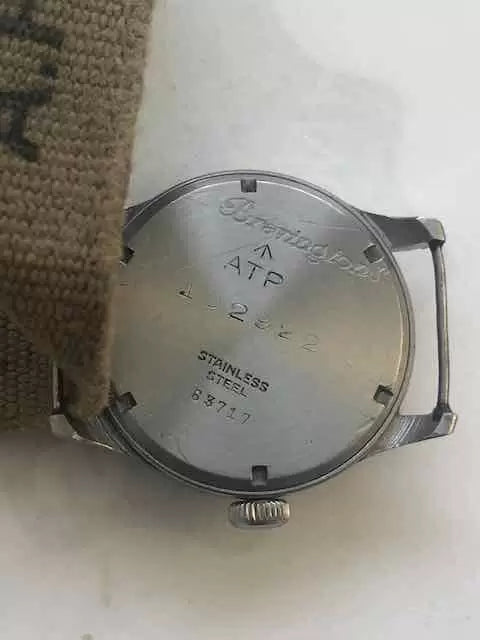
Below two MoD redialed watches, one sterile, and the other with a Unitas signature without the lines..


The ARSA D-H watch and the Unitas ATP watch used the same movement.
The German DH watch on the left below has 15 jewels, (15 rubris), and is signed ARSA, (A Reymond Ltd).⠀Beneath the ratchet wheel it is marked 173.
The British ATPs on the right are signed UNITAS, and 15 jewels,⠀and the central watch is also marked under the signature with 173.

Early serial number ARSA D-H watches have G.R. engraved inside the case back, and later serial numbers, F.T.
VARIATIONS
As mentioned above, some ATP watches went to other branches of the military. A selection are shown below. A sterile dial Grana, a Lemania, a Cortebert all re stamped 6E/385 and a Moeris T MoD redial re stamped HS11

Image courtesy : Konrad Knirim
VERTEX
The Vertex Revue 59 movement is used in the Revue 59 ATP as discussed above. Some call this watch the Vertex ATP, as the dial is sterile, and the movement is marked Vertex.
The Vertex WWW has been seen downgraded to an ATP standard. This is unusual, but has been seen above with the CYMA ATP.


WYLER
There are a few Wyler ATP watches that were possibly bought by the MoD during a supply shortage, like Eterna and Mido ATPs. Again these do not conform to the consensus definition of an ATP watch.
Below is a Wyler Special, about 29mm diameter with 14.6mm lug width case back engraved ATP with pheon. Centre seconds, black dial, shown on a 6B/2617 strap.


Another Wyler, again centre seconds, black dial.


And a centre seconds white dial Wyler Extraflat engraved ATP and Bravingtons.


Many of the Wyler ATPs were the Extraflat model.
Here a Wyler, sub second black dial, with a caseback also engraved ATP Bravingtons, shown on an AF0210 black strap.


And a Wyler Extraflat center seconds, on an AF0210 strap.

The Wyler ATP watch is often found without a crown, as it is a front loading watch with a split stem and crown.

It was waterproof without gaskets. In 1937 the company caused a stir by launching a water-resistant watch that was not fitted with the conventional soft gaskets. The mineral glass was pressed in between the edge of the monoblock case and a pressed or screwed bezel, the gap between the winding shaft and the watch case was sealed hydraulically by fitting the winding shaft and bushing together, in the same material, to 1/500 mm tolerance.
In 1944 a letter from Albert Einstein about the water resistant watch provided an excellent marketing opportunity.

FAKES
Some time ago, an Ebay seller Harrhay advertised some ATP watches, with the . in the ATP engraving at mid height, and serial numbers in the 5xxx range. An example is below.

Many of the manufacturers are American importers.

There are also some strange advertisements out there, e.g. for a Grana/Lemania with a sterile dial, and no hint of Grana.






